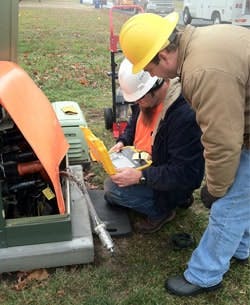Between a rock and a hard place: That’s where Joplin, Mo.-based Empire District Electric Co. found itself with its network of aging underground cable.
Most of Empire’s cable was installed in the 1970s, and about a decade ago, Empire c which serves around 215,000 customers in Missouri, Kansas, Arkansas and Oklahoma – faced a rising number of power outages. The lack of reliability frustrated residential and commerical customers, but outright replacement of the more than 17,000 feet of cable that needed initial attention was exceedingly expensive: Estimates were as high as $100 per square foot.
“Our terrain is very rocky, and we bedded the cable with agricultural limestone,” explains Wes Robertson, manager of line operations at Empire Electric. The limestone works its way into the insulation over time, he adds, making it extremely difficult to dig up the cable. In addition, whenever cable is replaced, a second trench has to be dug in order to install the new cable.
“We knew we were going to have to do something,” Robertson says – but replacement wasn’t it. Empire turned instead to cable rejuvenation, a process by which fluid is injected into cable segments, where it permeates the insulation and works to restore cable to full dielectric strength.
Robertson admits that he and the Empire team were skeptical at first about the efficacy of rejuvenation, appealing though the cost savings relative to cable replacement were. “It was hard to believe the process could be done with the cables energized,” Robertson says. But two rounds of injection, treating about 30,000 feet of cable, produced impressive results. Cable failures declined markedly and quickly. Certain residential subdivisions that had experienced as many as 80 cable failures a year saw their annual failures plummet to 10 to 12.
Fully sold on rejuvenation as a cable replacement alternative, Empire has expanded its rejuvenation work in the past decade. The company now injects around 15,000 feet of cable per year.
“Injection has given our cable a second life,” Robertson says. Power outages have declined by 85%–95%, and overtime hours for linemen have declined to fewer than 200 hours a year from 1,000.
“Cable injection is now one of our tools for ensuring system reliability,” says Robertson. He adds: “I think it’s pretty amazing to get another 20–25 years of life out of cable that was designed to last 25 years.”
Cable rehabilitation specialist Novinium developed the hybrid injection process that Empire chose for its rejuvenation project. Hybrid injection incorporates both low-pressure improved unsustained pressure rejuvenation (iUPR) and higher-speed sustained pressure rejuvenation (SPR) to give work crews the flexibility to choose a rejuvenation method based upon the characteristics of a particular cable segment.
Unsustained pressure rejuvenation has been around for more than 20 years; the “improved” part of iUPR, so named by Novinium, reflects the incorporation of newer, more-durable seals that lower the risk of injection fluid leaks (leaked fluid compromises injected cables’ reliability) and the use of proprietary reticular flash-prevention technology that reduces the chance for injection port flashover.
iUPR is slower than SPR is, typically requiring 12–24 hours for completion of the injection process and 18 months for the injection fluid to fully permeate cable insulation and return that cable to full strength. But the lower pressure means that fluid can flow safely through existing cable splices. Because no splice removal is required, iUPR can be an attractive choice for projects in which it would be difficult to access splices and/or cost-prohibitive to replace them. (Airflow and pressure tests are performed to make sure a given cable segment and splices are suitable for injection, Novinium notes.) The iUPR injection process typically cuts power from a cable segment for about 30 minutes.
SPR holds appeal for large injection processes because of its speed. A 300-foot segment takes around 30 minutes to complete, meaning that injection for an average-size project can be finished in a couple of hours. Injected cables will reach their full dielectric strength in a week.
With SPR, after splices are detected using a radio frequency locator and a measuring wheel, pits are dug and the splices are removed. A radial press is used to install injection adapters and a splice connector. Once the fluid is injected, injection equipment is removed, splice installation is completed and standard elbows are installed at each end.
Cable rejuvenation is “one of the tools we need to use systemwide,” Robertson says. “We are trying to be proactively injecting older cable rather than being reactive after a failure.”

